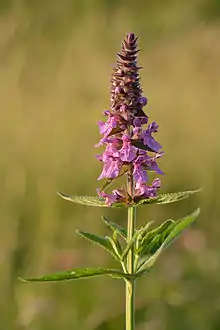Stachys palustris
Stachys palustris, commonly known as marsh woundwort,[2] clown's woundwort, clown's heal-all, marsh hedgenettle,[3] or hedge-nettle,[4] is an edible[5] perennial grassland herb growing to 80 centimeters tall. It is native to parts of Eurasia but has been introduced to North America.[4] The species epithet palustris is Latin for "of the marsh" and indicates its common habitat.[6]
| Stachys palustris | |
|---|---|
 | |
| Scientific classification | |
| Kingdom: | Plantae |
| Clade: | Tracheophytes |
| Clade: | Angiosperms |
| Clade: | Eudicots |
| Clade: | Asterids |
| Order: | Lamiales |
| Family: | Lamiaceae |
| Genus: | Stachys |
| Species: | S. palustris |
| Binomial name | |
| Stachys palustris | |
Description
Marsh woundwort is a perennial plant growing from a horizontal tuberous runner. It has square stems with opposite pairs of leaves that are almost stalkless, linearly lanceolate, slightly cordate at the base and toothed. The calyx has five sharply-pointed lobes. The purplish-red flowers are in terminal spikes, with gaps in the lower part of the spike. They are arranged in whorls, each flower consisting of five fused petals, the corolla being two-lipped, the upper lip being gently hooded and the lower lip flat and three-lobed. The flowers are mostly visited by bumblebees.[7] There are four stamens, two long and two short and the fruit is a dry four-chambered schizocarp.[8][9]
Distribution and habitat
The marsh woundwort is native to Europe and Asia. Its typical habitat is near the shore of lakes, in marshes with alder trees, on the banks of ditches and streams, in damp meadows, in arable ground and in waste places. In arable land, it is a difficult weed to get rid of because of its persistent tubers.[9]
Ecology
Although the marsh woundwort has little fragrance, it is very attractive to bumblebees. Nectar indicators guide the insect to probe into the centre of the flower and the anthers of the stamens and the pistils are correctly located for the insect to transfer pollen between flowers. The seeds of this plant disperse well, the dry fruit capsules float away and this probably why the plant is frequently found on the banks of lakes and other bodies of water. It also spreads vegetatively by means of hollow tuberous root which can throw up shoots far from the original plant.[9]
Uses
As their common names suggest, along with its close relatives field woundwort and hedge woundwort it is used to promote the healing of wounds. Wort is a middle English word for a herb or vegetable.
References
- "Stachys palustris". Germplasm Resources Information Network (GRIN). Agricultural Research Service (ARS), United States Department of Agriculture (USDA). Retrieved 10 January 2018.
- "BSBI List 2007". Botanical Society of Britain and Ireland. Archived from the original (xls) on 2015-01-25. Retrieved 2014-10-17.
- "Stachys palustris". Natural Resources Conservation Service PLANTS Database. USDA. Retrieved 30 November 2015.
- Dickinson, T.; Metsger, D.; Bull, J.; & Dickinson, R. (2004) ROM Field Guide to Wildflowers of Ontario. Toronto:Royal Ontario Museum, p. 298.
- northern bushcraft
- Archibald William Smith A Gardener's Handbook of Plant Names: Their Meanings and Origins, p. 258, at Google Books
- Van Der Kooi, C. J.; Pen, I.; Staal, M.; Stavenga, D. G.; Elzenga, J. T. M. (2015). "Competition for pollinators and intra-communal spectral dissimilarity of flowers". Plant Biology. 18 (1): 56–62. doi:10.1111/plb.12328. PMID 25754608.
- Webb, D.A., Parnell, J. and Doogue, D. (1996) An Irish Flora. Dundalgan Press (W.Tempest) Ltd. ISBN 0-85221-131-7
- "Marsh woundwort: Stachys palustris". NatureGate. Retrieved 2013-12-14.
External links
| Wikimedia Commons has media related to Stachys palustris. |